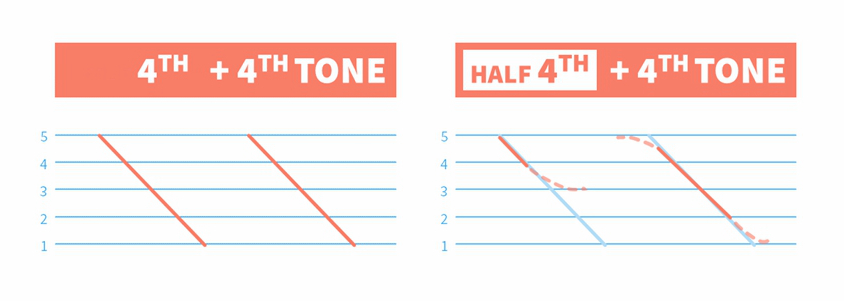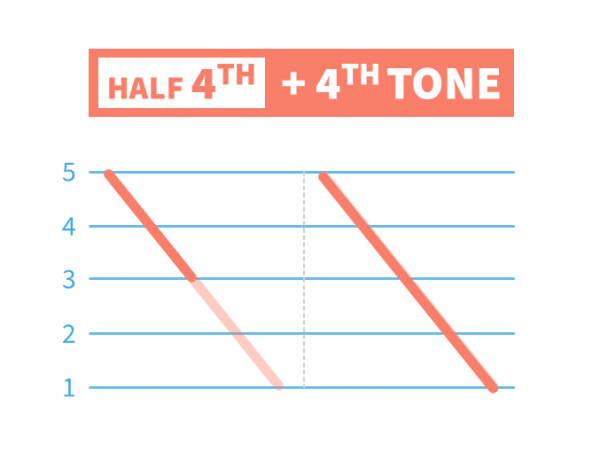Tone Lesson 10 – Chinese Tone Change Rules: Two Fourth Tones Together

PINYIN TONE CHANGE RULE: CHINESE TWO FOURTH TONES TOGETHER
We have practiced the Fourth Tone in Lesson 4, and today we will practice a Pinyin Tone change rule of the Fourth Tone. That is “Chinese Two Fourth Tones Together”. This is a very important Pinyin Tone Sandhi for learners who want to sound native. Basically, when there are two Fourth Tones together, the first one becomes a Half Fourth Tone. Let's practice and master the pronunciation!
How to Pronounce Chinese Two Fourth Tones Together
When to pronounce the Fourth Tone, we start very high, and then immediately drop down. The original Fourth Tone sounds very quick and firm, to the point that some learners might even feel that it sounds angry. As shown in the picture, the Fourth Tone drops from 5 to 1. If there are two Fourth Tones together, to pronounce the second one we need to jump from the lowest all the way to the highest. This is not the most relaxed pronunciation to do, so people tend to compensate and make the first one a Half Fourth Tone, which does not drop all the way down but stops semi-high in the middle.

Half Fourth Tone VS. Original Full Fourth Tone
In a 2-syllable word, when there are two Fourth Tones together, syllable 1 becomes a Half Fourth Tone and syllable 2 stays as the Original Full Fourth Tone. This Pinyin Tone change rule might not be as much discussed as Two Third Tones together or the Neutral Tone. But if you want to sound more natural and native, some practice on this Pinyin Tone Sandhi is beneficial.

Pinyin Tone Change Rule: Chinese Two Fourth Tones Together
For the 2-syllables words below, syllable 1 is pronounced in the Half Fourth Tone syllable, while syllable 2 is pronounced in its Original Full Fourth Ton
HALF FOURTH TONE + FULL FOURTH TONE
| GROUP 1 | ||
|---|---|---|
| PINYIN | 汉字 | ENGLISH |
| zhào lì | 照例 | as usual |
| zài jiàn | 再见 | goodbye |
| shuì jiào | 睡觉 | to sleep |
| kàn jiàn | 看见 | to see |
| SENTENCE | ||
| wǒ kànjiàn tā zhàolì zài shuìjiào . | ||
| 我看见他照例在睡觉。 | ||
| I see that he was sleeping like usual.. | ||
HALF FOURTH TONE + FULL FOURTH TONE
| GROUP 2 | ||
|---|---|---|
| PINYIN | 汉字 | ENGLISH |
| shì jiè | 世界 | world |
| zuì jìn | 最近 | recently; lately |
| zhòng yào | 重要 | important |
| huì yì | 会议 | meeting; conference |
| SENTENCE | ||
| wǒ zuì jìn méi yǒu zhòng yào huì yì | ||
| 我最近没有重要会议。 | ||
| I haven’t had any important meetings lately. | ||
By far the hardest one, any tips on what to focus on specifically?
Hi again, i found out the reason already. Thanks:)
Hi, I have finished all lessons of Tone Drills and they all have green check, except for the lesson 10, would you please help me check:). Thank you!
你好。 The first sentence of this lesson wǒ kànjiàn tā zhàolì zài shuìjiào was translated as follow: I see that he was sleeping like usual. Why is the past tense used?? It shouldn’t be I see that he is sleeping like usual?? I don’t see any context referring to the past tense.
Thanks in advance for your help.
再见
It is not part of this course but in Chinese there is no concept of “Tense”, there is only the concept of “Aspect”. Please refer to Aspect in Chinese vs. Tense in English in our structured course.
Why was the third tone in ‘méi yǒu’ in this sentence
wǒ zuì jìn méi yǒu zhòng yào huì yìmodified into a half third tone? It’s a two syllable word with the second syllable being the third tone. Lesson 6 said not to modify it. And méi yǒu does not describe the following word in the sentence. What have I missed?In Lesson 6 the Third Tone was not modified in the words because it was not followed by any syllable, meaning it’s at the end.
In the sentence “wǒ zuì jìn méi yǒu zhòng yào huì yì”, yǒu is followed by “zhòng”. In a sentence, it’s natural for neighboring syllables to affect each other.
(We didn’t mention Half-Third Tone in the example sentences in Lesson 6 because at that point the Half-Third Tone has not been introduced yet and we wanted to focus on the content in that lesson only. But technically only the syllable at the end of the sentence is sopposed to be pronounced as an Original Full Third Tone.)